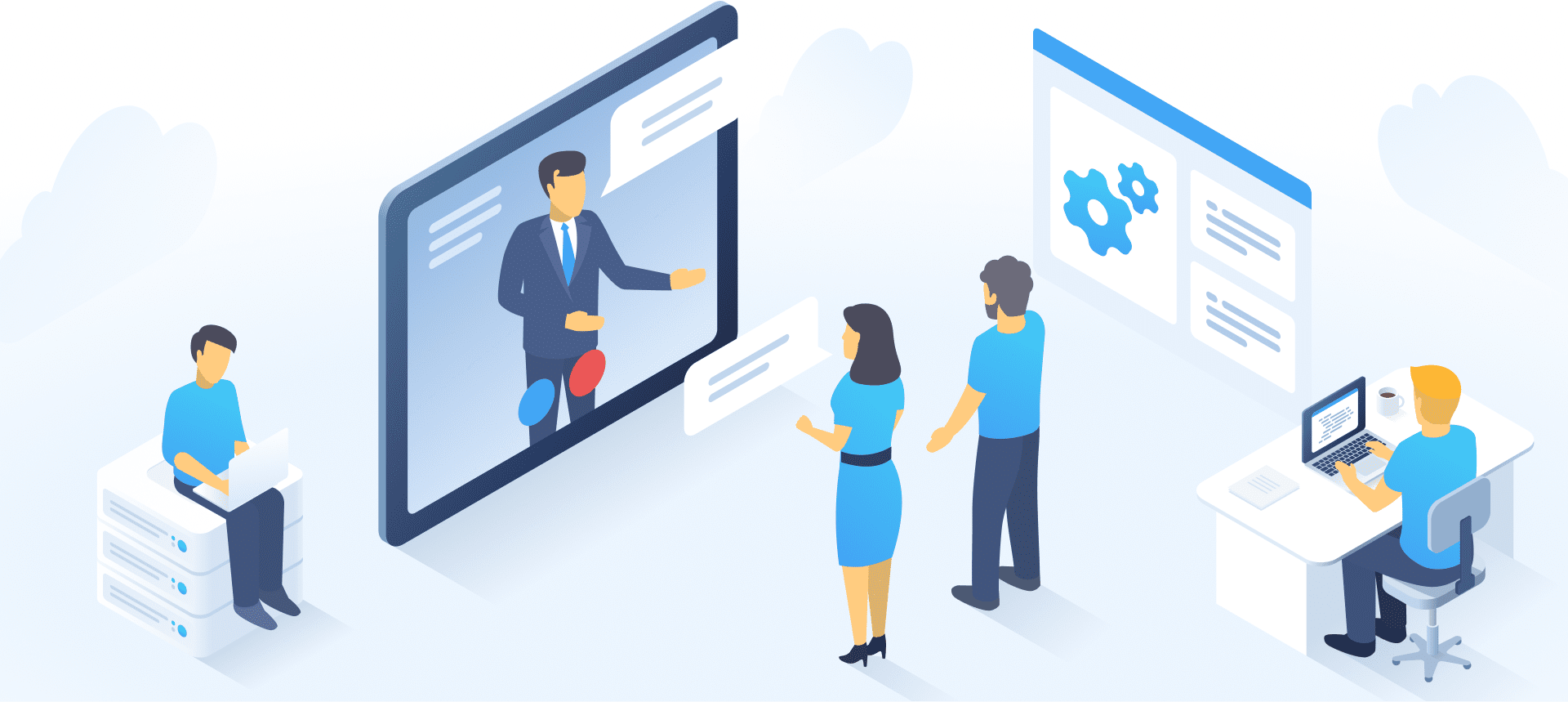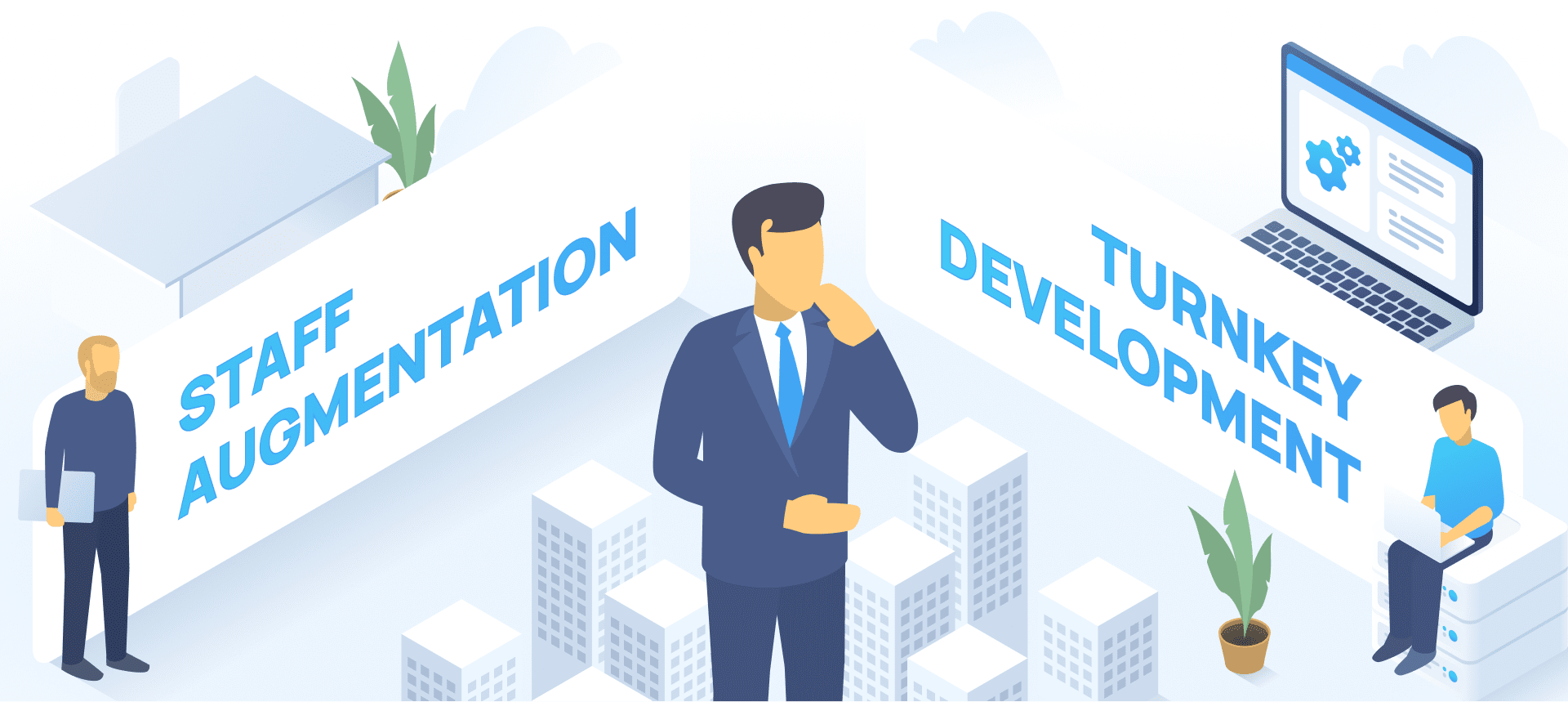Pros & Cons of Staff Augmentation and Turnkey Development: Which One to Choose?
Volodymyr Rudyi

Information Services Group (ISG) reports that IT services compose 72% of the global outsourcing market. Such numbers are provoked by the high demand for technical talents, especially in the realms of cloud computing, cybersecurity, robotic process automation (RPA), artificial intelligence (AI), and machine learning (ML). Thus, modern businesses must hire the top candidates for their software development projects faster and more efficiently.
Fortunately, services like staff augmentation and turnkey development are among the most crucial options to do that appropriately. Each model can give your company access to specific skills and knowledge your internal team lacks. That guarantees better flexibility during the development of digital products and speeds up their launch to the market. But at the same time, both approaches are perfect when meeting particular business requirements.
Today, we will compare staff augmentation and outsourcing by exploring their critical benefits and drawbacks. We will explain how each model can satisfy your project needs, save costs, and increase agility, which can be essential for your company to choose the right option.
Staff Augmentation: Pros & Cons
Staff augmentation means hiring additional IT professionals on a temporary or project-based basis. This approach helps your company to supplement your current workforce effectively. The qualified tech talents bring the required expertise and experience to assist your in-house team in delivering projects faster and performing various complex tasks. Meanwhile, there is no need for your organization to focus on long-term hiring.

You should understand that the staff augmentation model will not replace your core team. From a technical point of view, these external specialists serve as contractors. Their hiring, retention, and financial bonuses are the responsibilities of a particular full-service company.
Key Advantages of Staff Augmentation
After learning what team augmentation is, let’s consider the most essential benefits of this engagement model.
- Improved flexibility. Staff augmentation offers greater flexibility, which allows you to address always-changing market requirements and demands. This model enables companies to scale the necessary human resources up or down, forgetting about the commitment to long-term employee engagement and costs. Compared to in-house teams, the flexibility provided by staff augmentation helps optimize resources.
- Focus on core business tasks. With team augmentation, you can delegate specific tasks to professionals with relevant skills. The latter can complete this work correctly, which empowers your internal staff to concentrate on core business competencies. That contributes to making your company future-oriented. In many cases, full-service providers can even deprive you of the office routine with effective staff management.
- Quick integration into the project. The rigorous vetting of the hired talents is also a vital advantage of team augmentation. This approach allows organizations to ensure that augmented professionals match their corporate culture, values, and needs. It is critical for their seamless integration with your in-house developers and quick project start. Besides, it promotes fruitful collaboration and faster achievement of project objectives, which gives you a competitive edge within your industry.
- Time and money savings. A staff augmentation model helps save time and money significantly since it eliminates typical hiring challenges. For instance, reliable team augmentation vendors take responsibility for full-cycle services, including recruiting, onboarding, benefits payout etc. Also, the cost structure’s transparency and constant access to augmented staff ensures you have control over the costs and critical project milestones.
- Knowledge transfer. Augmented team members have outstanding tech skills and experience working with various businesses across various industries. Therefore, when cooperating with such specialists, your in-house developers can enrich their knowledge related to software development. Besides, they get valuable insights into new technologies, emerging trends, and most influential industry practices.
Key Drawbacks of Staff Augmentation
Although team augmentation is often an advantageous engagement model for software development projects, it also has some crucial challenges. Let’s check them below.
- Hiring the required specialists. IDC reports that we should expect a shortfall of 4 million software developers by 2025. In such a case, companies will find it incredibly hard to find the right professionals with the necessary skill set despite their location. To address this issue, you can partner with an experienced vendor with enough resources to satisfy your business needs. That also eliminates the need for further rehiring, which will allow for saving significant costs.
- Communication and team management. The feeling of isolation and struggles to find a work-life balance are usual for over 30% of remote staff. And it is the issue your business may face, making it challenging to ensure proper team management and maintain open and constant communication. Here, you should use real-time collaboration software, conduct regular online meetings, and organize team-building activities. That will empower your augmented team to feel more engaged.
- Project knowledge transfer. You will struggle with great issues if your organization cannot provide a smooth and efficient project knowledge transfer process. That may cover quality inconsistency, missed deadlines, and other project failures. Postponing your product’s launch date or switching to another vendor can be inevitable in such a situation. But it means time and cost wasting. To avoid these problems, you should design and execute a result-oriented strategy for transferring project knowledge.
Scalability. In team augmentation, scalability can simultaneously be an advantage and a drawback. For example, your company may face hurdles when recruiting professionals with experience in a rare technology stack. And the issue can grow if your augmented team has a high attrition rate. However, partnering with a software development vendor who can find the best candidates for various tech stacks may come in handy. So, you should choose the one who knows how to do that properly.
Turnkey Development: Pros & Cons
Turnkey development offered by an outsourcing partner is a well-known alternative to the team augmentation model. It involves partnering with an external software development vendor to perform specific tasks or projects without doing the relevant work in-house. An outsourcing model can also help your company save time and money, as you are not responsible for training and managing developers who perform the work.

Key Advantages of Turnkey Development
When it comes to getting turnkey development services from an external vendor, the benefits are the following:
- Better flexibility. Like team augmentation, turnkey development outsourcing enables your organization to complete relevant projects without hiring, retaining, or firing specialists. Thus, you can expect quicker and more effective delivery. Also, you can divide your project into several smaller parts, outsourcing them to multiple vendors. That may assist in meeting deadlines, which is often impossible with your in-house developers only.
- Robust expertise and experience. Each successful turnkey development partner has expanded its expertise, competencies, and knowledge over time. For instance, AgileVision always cooperates with clients representing various industries to address their crucial challenges. These are mostly related to developing software solutions, hardware, and systems. Therefore, your business can rely on experienced and reputable vendors who leverage the latest tech innovations and market trends.
- Service level agreements (SLAs). Outsourcing companies that provide turnkey development services always base their offerings on SLAs. The particular contract obligations force your partner to deliver project outcomes according to previously defined quality standards and key performance metrics. In addition, SLAs define the necessary timeframes to meet the service levels. That results in higher reliability compared to internal software development.
- Faster time-to-market. Turnkey development allows for speeding up your software project delivery. Since an efficient outsourcing vendor has scalable resources and vast development expertise, the project execution becomes much faster. After all, they establish a dedicated focus on finishing projects depending on the agreed-upon deadlines. That brings a competitive advantage in terms of faster time-to-market.
Key Drawbacks of Turnkey Development
All engagement models have advantages and disadvantages, and turnkey development is no exception. Below are some critical drawbacks to consider and helpful tips on addressing them appropriately.
- Inappropriate internal expertise. When your company relies on an outsourcing partner too much, your internal skills and knowledge can be affected. In this case, your business might even be obliged to regard turnkey development as a mandatory step. That is because your internal developers cannot perform further tasks, including software updates and continuous maintenance. Here, you must provide proactive knowledge transfer to keep vital expertise within your company.
- Lack of control. Outsourcing turnkey software development means you have little control over final project outcomes. Such conditions are often problematic, primarily if your vendor cannot provide the expected quality or stay within the defined deadlines. Besides, cooperating with an external team may become challenging because of its location in a different time zone. So, you can leverage the available software tools to know everything is going well and avoid communication and management issues.
- Information security and privacy. Data breaches or loss are always risks due to hackers’ attacks or unintentional mistakes. But when you entrust the crucial company data to an external vendor, this risk is even higher. You should implement strict security measures and sign confidentiality agreements (NDAs) to prevent the issue. Also, your company may ask an outsourcing partner to sign a specific legal contract that makes them responsible for data security during the development process.
How Do Team Augmentation and Turnkey Development Outsourcing Differ?
An augmented team model and outsourcing software development are popular approaches that assist your organization in achieving higher efficiency and reducing costs. And although they have some critical similarities, you should know the main differences between these engagement models.
- Involvement scope. Turnkey development predicts fully outsourcing projects to a software development vendor. Meanwhile, team augmentation is about hiring remote staff with the required skill sets and experience to deliver relevant projects or tasks with your internal developers.
- Resource allocation. An augmented team model primarily depends on employees’ knowledge and expertise to deliver a project properly. Instead, outsourcing turnkey development makes a vendor responsible for facilitating all the required resources, skill sets, and experience to complete tasks. In the second case, your company only pays for services provided.
- Level of control. Staff augmentation gives your business direct control over remote employees and allows for managing them on your side. On the other hand, turnkey development means delegating control and management duties related to the project to your outsourcing partner.
- Cost structure. Members of your augmented team get payments based on their hourly or monthly rates. But there can be various pricing models when you choose turnkey development (for instance, outcome-based or fixed-price).
Considering these differences, you can decide what will be perfect for your organization.
Staff Augmentation vs. Turnkey Development: Which Is Your Ideal Option?
Making a particular decision may seem daunting at first glance since these two models can provide desirable project outcomes. But if your objective is to strengthen your internal developers with specific knowledge or rare tech expertise from remote staff, you should pay more attention to team augmentation. Besides, this option is great if your company aims to cooperate with external professionals while retaining full control over project execution.

However, if your software project is complicated and needs dedicated focus and specific resources, you should consider outsourcing turnkey development. Here, you will not be responsible for project management and have no direct control over it. That is because your outsourcing partner ensures effective resource allocation and project execution to provide defined deliverables on time, meeting all quality standards.
Final Word
To conclude, team augmentation and turnkey development outsourcing have a proven track record of success stories within various industries. They have already effectively replaced usual hiring models as they eliminate many recruitment challenges. Each approach can help your organization speed up a product launch and minimize costs while working with qualified and experienced talent pools worldwide. However, your chosen model will always depend on your unique project requirements, goals, and company policies.
Are you still deciding between staff augmentation and turnkey development outsourcing? Contact us today to understand which approach can better meet your needs and discuss how AgileVision can implement it for your new software project.


